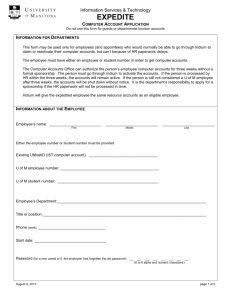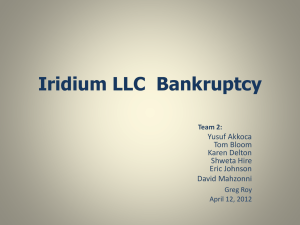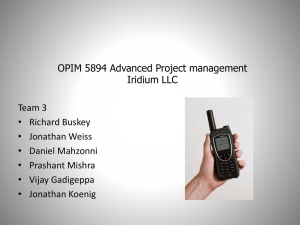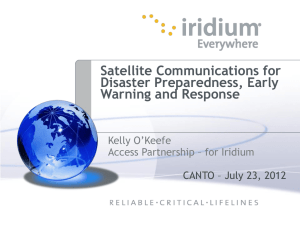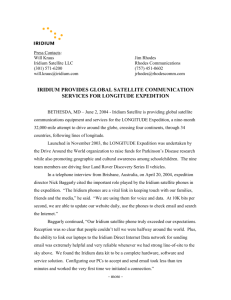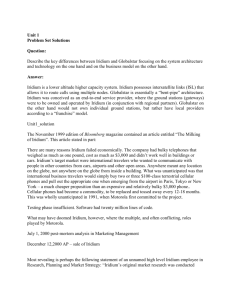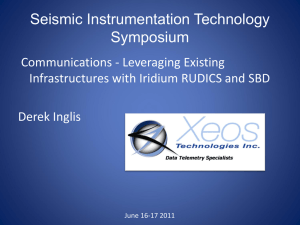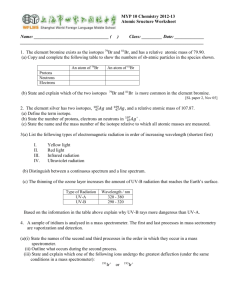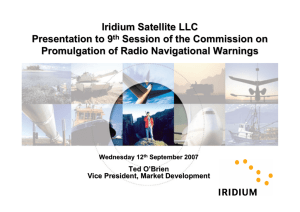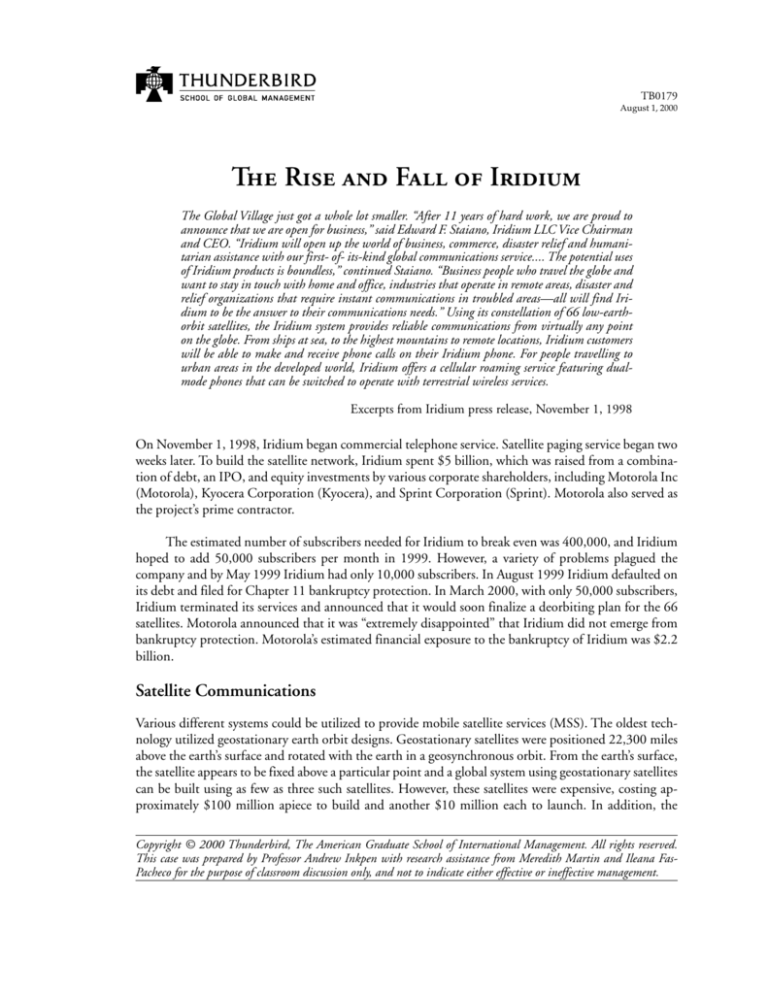
TB0179
August 1, 2000
The Rise and Fall of Iridium
The Global Village just got a whole lot smaller. “After 11 years of hard work, we are proud to
announce that we are open for business,” said Edward F. Staiano, Iridium LLC Vice Chairman
and CEO. “Iridium will open up the world of business, commerce, disaster relief and humanitarian assistance with our first- of- its-kind global communications service.... The potential uses
of Iridium products is boundless,” continued Staiano. “Business people who travel the globe and
want to stay in touch with home and office, industries that operate in remote areas, disaster and
relief organizations that require instant communications in troubled areas—all will find Iridium to be the answer to their communications needs.” Using its constellation of 66 low-earthorbit satellites, the Iridium system provides reliable communications from virtually any point
on the globe. From ships at sea, to the highest mountains to remote locations, Iridium customers
will be able to make and receive phone calls on their Iridium phone. For people travelling to
urban areas in the developed world, Iridium offers a cellular roaming service featuring dualmode phones that can be switched to operate with terrestrial wireless services.
Excerpts from Iridium press release, November 1, 1998
On November 1, 1998, Iridium began commercial telephone service. Satellite paging service began two
weeks later. To build the satellite network, Iridium spent $5 billion, which was raised from a combination of debt, an IPO, and equity investments by various corporate shareholders, including Motorola Inc
(Motorola), Kyocera Corporation (Kyocera), and Sprint Corporation (Sprint). Motorola also served as
the project’s prime contractor.
The estimated number of subscribers needed for Iridium to break even was 400,000, and Iridium
hoped to add 50,000 subscribers per month in 1999. However, a variety of problems plagued the
company and by May 1999 Iridium had only 10,000 subscribers. In August 1999 Iridium defaulted on
its debt and filed for Chapter 11 bankruptcy protection. In March 2000, with only 50,000 subscribers,
Iridium terminated its services and announced that it would soon finalize a deorbiting plan for the 66
satellites. Motorola announced that it was “extremely disappointed” that Iridium did not emerge from
bankruptcy protection. Motorola’s estimated financial exposure to the bankruptcy of Iridium was $2.2
billion.
Satellite Communications
Various different systems could be utilized to provide mobile satellite services (MSS). The oldest technology utilized geostationary earth orbit designs. Geostationary satellites were positioned 22,300 miles
above the earth’s surface and rotated with the earth in a geosynchronous orbit. From the earth’s surface,
the satellite appears to be fixed above a particular point and a global system using geostationary satellites
can be built using as few as three such satellites. However, these satellites were expensive, costing approximately $100 million apiece to build and another $10 million each to launch. In addition, the
Copyright © 2000 Thunderbird, The American Graduate School of International Management. All rights reserved.
This case was prepared by Professor Andrew Inkpen with research assistance from Meredith Martin and Ileana FasPacheco for the purpose of classroom discussion only, and not to indicate either effective or ineffective management.
distance from the earth’s surface to the satellite can cause a quarter of a second delay between sending
and receiving, which can be annoying to callers.
Low-earth-orbit (the system utilized by Iridium) and medium-earth-orbit satellites did not have a
time-delay problem and were much less expensive to produce and launch. However, instead of appearing stationary over a particular point on the earth’s surface, these satellites flew overhead at speeds of
more than 15,000 miles per hour. Tracking them from the ground and handing off calls from satellite to
satellite was complicated and expensive. The expected failure rate of such satellites was around 10% and
life expectancy ranged from five to seven years once the satellite was in orbit.
The Creation of Iridium
Iridium was designed to be a satellite-based, wireless personal communications network which would
permit any type of telephone transmission, including voice, data, fax, and paging to reach its destination
at any time, at any location in the world. The genesis for Iridium was in 1986 when the general manager
of Motorola’s Strategic Electronics Division (which was involved primarily in space-related business)
formed a small R&D group within his division. Motorola’s previous space-related experience had been
as a subcontractor for defense contracts. Firms such as Lockheed Corporation were the prime contractors and outsourced the electronics work to Motorola and other companies. However, there was a belief
in Motorola’s space division that advances in electronics would allow Motorola to change the rules of
space competition and become a prime contractor. The R&D group was asked to look for opportunities
that could leverage Motorola’s distinctive competence in high-density electronics. In addition, the group
was asked to consider commercial and defense applications.
In 1987 the Strategic Electronics Division R&D group invented a satellite communication system
(see Exhibit 1 for the timing of key events). The system, named Iridium, derived its name from the
element Iridium, whose atomic number, 77, matched the number of low-earth-orbit satellites that the
company had originally intended to launch. According to a senior Motorola manager:
The space industry was almost entirely focused on defense business. The emphasis was on failsafe systems, redundancy, and space-qualified parts. The result was always gigantic costs overruns. We took all the conventions of building a spacecraft and changed them. Iridium was
designed as a statistically based system in which a single satellite failure would not be a catastrophic failure. We designed satellites with little redundancy and lowered the cost of building a
satellite by a factor of ten. We did not need space qualified parts, which were incredibly expensive and not very reliable because of their low volumes. We went to the Motorola automotive
division to learn about components for high-volume manufacturing.
From late 1987 through 1988, Motorola analyzed the technological and commercial viability of
Iridium. In the fall of 1989 Motorola’s CEO, Robert Galvin, announced internally that the company
would develop the Iridium project. In early 1990 an Iridium business unit was formed with about 20
people. Motorola announced the project in June 1990 with simultaneous press conferences in Beijing,
London, Melbourne, and New York.
Radio spectrum was allocated to Iridium in 1992. Obtaining the spectrum required overcoming
substantial resistance from INMARSAT, a global satellite communications company owned by about
80 governments. INMARSAT, whose principle service was emergency communications for ocean-going ships, waged an unsuccessful battle to keep Iridium from obtaining an operating license.
At the time Iridium was conceived, cellular or mobile phones were of limited use when users
crossed international borders. Europe, for example, had many different mobile standards, which meant
2
TB0179
a German phone would usually not work in France or Italy. Motorola management saw an opportunity
to build a communications network that had a common standard and allowed users to use their phones
anywhere in the world. At the time, it was believed that the potential demand for such a service was
enormous, especially for voice telephony from the business and military community. Prior to the system’s
launch, the company predicted a market of 12 million satellite phone users by 2002 and a 40% share for
Iridium. The company also predicted 100 million cellular phone users by 2000.
Ownership Structure
Iridium, Inc. was incorporated in June 1991 and operated as a wholly owned subsidiary of Motorola.
However, Motorola’s intent was never to operate as a service provider. In July 1999 Iridium privately
sold shares of common stock to various U.S. and foreign investors. By 1994 Iridium had $1.6 billion of
equity financing in place. A further $315 million of equity was secured during the first quarter of 1996.
In June 1997 Iridium shares went public at $20, raising $225 million. Investor demand for Iridium
shares was strong.
As a result of three private placements of equity, five supplemental private placements with additional equity investors, and proceeds received from the initial public offering of Iridium common stock,
Motorola’s interest in Iridium was reduced to approximately 19%, for which it had paid $365 million.
The Japanese components maker, Kyocera, and affiliates held an 11% stake in the company. Other
investors included Sprint, Vebacom (Germany), Lockheed (U.S.), Raytheon (U.S.), Telecom Italia, a
consortium built around the Japanese carrier, DDI, a consortia of Middle East, African, and South
American companies, and companies from China, Canada, Thailand, South Korea, Russia, Taiwan,
and India. Most of the companies involved in the consortia and equity placements were new telecom
entrants or second carriers in the telecommunications field.
Background on Motorola and Kyocera
Motorola. In 1928 Paul Galvin and his brother, Joseph Galvin, purchased a bankrupt battery eliminator
business in Chicago and formed the Galvin Manufacturing Corporation. The company’s first product,
a battery eliminator, enabled battery-operated home radios to operate on ordinary household current.
In 1930 the company introduced the first practical and affordable car radio. Paul Galvin used the name
Motorola for the company’s new products, linking the ideas of motion and radio. The company’s share
of the car radio business increased rapidly and established the company as a leader in the U.S. market by
1936. In 1940 a communications division was established. Shortly after, this division developed the
first hand-held two-way radio for the U.S. Army and the first commercial line of two-way FM radio
communications products. By 1947 the Motorola trademark was so widely recognized that the Galvin
Manufacturing Corporation changed its name to Motorola, Inc. Over the next five decades, Motorola
developed a diverse mix of products that lead to the company becoming a global leader in providing
integrated communications and electronic solutions. Over the years, in addition to car and two-way
radios, Motorola developed televisions, pagers, transponders, cellular phones and systems, and semiconductors. In 1999 Motorola’s communications and electronic businesses focused on software-enhanced communications products and systems, networking and internet-access products, digital and
analog systems for broadband cable television, and semiconductors. Motorola was composed of three
business units: Integrated Electronic Systems, Semiconductor Products, and the Communications Enterprise. Motorola was headquartered in Schaumburg, Illinois, and had a sales presence in almost every
country. Sales for 1999 were $30.9 billion.
Kyocera. Founded in 1959 by Dr. Kazuo Inamori and seven colleagues as a manufacturer of a new
advanced ceramic technology they had developed, Japan-based Kyocera diversified from electronic packTB0179
3
ages and components into optical and electronic systems. After more than four decades, Kyocera had
grown into a global producer of high technology solutions in many areas, such as telecommunications,
electronics, metal processing, automotive components, and solar energy. Kyocera operated with two
fundamental objectives. The first was to continually improve its product offerings through the technological integration of its advanced materials into existing and emerging businesses. The second objective
was to develop products responsive to marketplace needs through vertical integration. Kyocera management believed that production and marketing activities should be managed locally because of each
country’s unique culture. This belief made Kyocera one of the first Japanese companies with overseas
facilities and marketing organizations. Kyocera was divided into three business segments: Ceramics and
Related Products, Electronic Equipment, and Optical Instruments. In 1999 Kyocera was one of the
world’s leading producers of telecommunications equipment, including wireless phones. During 1999
Kyocera introduced the world’s lightest CDMA cellular handset, the world’s smallest satellite phone,
and the world’s first wireless, handheld videophone with color display. Kyocera’s consolidated total net
sales and operating revenue for fiscal year 1999 totaled ¥725 billion (yen) or $6.14 billion (at an exchange rate of ¥118/$).
Iridium Costs and Financing
The initial estimated cost of building the Iridium network was $3.5 billion. Based on the initial design,
Motorola, as prime contractor, completed the project on time and on budget and above specifications.
However, additional features and technologies that were added after the project began resulted in the
actual cost eventually growing to more than $5 billion. The capital cost consisted of two components:
1) the Space System contract for the design, development, production, and delivery of the satellites into
orbit; and 2) the Terrestrial Network Development contract to design the gateway hardware and software. The $1.8 billion Operations and Maintenance (O&M) contract dealt with the day-to-day management of the satellites after deployment. The contract provided for monitoring, upgrading, and replacing hardware and software as necessary to maintain performance specifications. Motorola’s Satellite
Communications Division was general contractor for the space system and terrestrial network components and also had the contract to provide O&M.
Lockheed Corporation designed and constructed the satellite bus, and Raytheon Corporation
designed the antenna for communication between the satellites and Iridium telephones. The Canadian
firm, COMDEV, was responsible for the antennas for intersatellite and gateway links. Telesat, Siemens,
Telespazio and Bechtel were other key suppliers. Three suppliers from around the world were used to
launch the satellites: Khrunichev Enterprise of the Russian Federation, China Great Wall Industry Corporation, and McDonnell Douglas (subsequently Boeing Corp).
Substantially all of the initial capital raised by Iridium was used to make payments to Motorola
under the Space System contract, the Terrestrial Network Development contract, and the O&M contract. The Space System contract provided for a fixed price (subject to certain adjustments), scheduled
to be paid by Iridium to Motorola over approximately a five-year period as milestones under the contract were completed. As of March 1, 1999, Iridium had incurred all of the $3.435 billion estimated
cost of the Space System contract and all but $5 million had been paid. As of March 1, 1999, Iridium
had incurred $302 million of the $356 million estimated cost of the Terrestrial Network Development
contract. According to the contract, Iridium was supposed to pay $120 million under the Terrestrial
Network Development contract in 1999 and the remaining $10 million in 2000.
From July 1993 to December 1998, Iridium spent $4.8 billion. The expenditure was funded with
1) $500 million in secured bank debt; 2) $625 million in bank debt guaranteed by Motorola; 3) $1.62
billion from the issuance of debt securities; 4) $2.26 billion from the issuance of stock (private place4
TB0179
ment and IPO); and 5) $86 million of vendor financing. By March 1999 the amount of secured bank
debt had increased to $800 million. The target leverage ratio was 60%, based on the theory that Iridium, once built, would resemble a utility with high margins, high fixed costs, and steady cash flows.
Motorola agreed to permit Iridium to defer its O&M obligations up to a total of $400 million
until December 29, 2000. Total O&M payments were expected to be $2.89 billion over the initial fiveyear term of the contract between Motorola and Iridium. In addition to deferring O&M payments,
Motorola guaranteed a significant amount of the bank financing and provided a guarantee in the event
that additional bank financing up to $400 million was necessary.
Iridium Service
Motorola eventually launched 66 satellites into low-earth-orbit, approximately 485 miles above the
earth’s surface, and Iridium initiated service on November 1, 1998. Although a 10-15% failure rate for
satellite deployment was normal, Motorola had a perfect record in satellite deployment. The satellites
were mainly constructed and tested in Motorola’s Satellite Communications Group facility in Chandler, Arizona. Because of the number of satellites, Motorola had to design a much more efficient production process than had been used previously by satellite manufacturers. Motorola developed an assembly line production process that allowed up to ten satellites to be under assembly at one time. Each
satellite carried its own phone switching system and the network used complex satellite-to-satellite links
that permitted phone calls to be switched in the sky. Although this feature substantially improved
coverage and performance, the weight of the satellite increased very little because of advances in electronics. Based on statistical analysis, the satellites were expected to last about six years before they would
burn up in the earth’s atmosphere, although sufficient fuel was provided for eight years.
Because of the nature of low- to medium-orbit satellites and the need to hand off calls from
satellite to base station anywhere in the world, Iridium had to register user-link frequencies in every
country around the world and obtain additional necessary operating permits. Nineteen strategic partners from around the world supported the Iridium system (Exhibit 2). Seventeen of the partners also
participated in the operation and maintenance of 12 ground station “gateways” that linked the satellite
system to terrestrial networks. The gateways, primarily telecom authorities and service providers in
different countries, provided the terrestrial switching and call routing and served as regional distributors
of Iridium services. The gateway partners shared in the revenue generated by Iridium calls. Although a
few countries chose not to participate in the Iridium network, the countries that did participate made it
possible to service most of the world’s population.
The handsets were manufactured by Motorola and Kyocera and were seven inches long (plus
antenna), weighed approximately one pound (Iridium promotional material described the handsets as
“small, lightweight, hand-held telephones”), and retailed between $2,200 and $3,400. When Iridium
service began, Iridium announced that Motorola and Kyocera, the manufacturers of Iridium satellite
telephones and pagers, were expected to produce more than 100,000 satellite telephones in 1998. Service fees ranged from just under $2 per minute to as much as $7 per minute for some international calls.
Management
Edward Staiano, formerly the head of Motorola’s cellular phone division, was appointed Iridium’s CEO
and vice chairman in 1996. Staiano became head of the cell phone division in 1984 and by 1996,
division revenue was $11 billion. Staiano “personified the hardball, controlling leadership that got
Motorola into trouble earlier in the year.”1 According to Forbes, one of Staiano’s first major decisions
1
Quentin Hardy, “Surviving Iridium,” Forbes, September 6: 216-217.
TB0179
5
was to ban all vacations at Iridium. The Iridium board was comprised of 28 telecom executives and
investor representatives from around the world. Except for two independent directors who received
$20,000 per year and 1,000 options, none of the other directors received compensation from Iridium.
Iridium operating companies were set up around the world (Exhibit 3).
Competition
In the mid-1990s, various experts and industry analysts were predicting that mobile satellite telephones
would experience huge growth rates over the subsequent decade. In a 1995 speech,2 Steven Dorfman,
president of Hughes Telecommunications and Space Company, one of the leading suppliers to the
satellite industry, predicted that by the first years of the 21st century there would be 25 million satellite
mobile telephones in use. Dorfman also predicted that the global satellite phone would be compatible
for both terrestrial and satellite systems and would be used for voice, data, fax, and e-mail communications. Because satellites were not linked with borders, Dorfman argued that the traditional distinction
between national and international telecom would soon disappear.
Largely in response to glowing predictions like that from Steven Dorfman, Iridium faced significant competition from MSS companies. The largest MSS competitors included Globalstar, Teledesic,
and ICO Global Communications. Iridium had an eighteen-month lead over its MSS competition. As
well, ground-based mobile networks were rapidly exploiting new technologies and building scale throughout the 1990s.
Globalstar
Globalstar had its roots in a 1989 plan at Ford Motor Company to use satellites to aid motorists.
However, Ford’s satellite unit was acquired by Loral Corporation in 1990 and Globalstar emerged in its
present form through an alliance that Loral struck with several engineering firms and large wireless
providers. The investment in Globalstar totaled $3.8 billion and Loral owned 45% of the company.
Other investors included Qualcomm, France Telecom, and AirTouch (now part of Vodaphone). The
system began limited commercial service in late 1999.
The Globalstar network was built with 52 low-earth-orbit satellites. Unlike Iridium’s satellites
which had their own phone switching systems, Globalstar’s satellites were like flying antennas, carrying
calls to switching systems on the ground which were simple to operate and were linked into local
networks. Globalstar’s satellites, although simpler and cheaper than Iridium satellites, required ground
switching systems and, therefore, coverage was restricted to land locations. Globalstar suffered a setback
in September 1998 when 12 satellites were lost in a single failed launch on a Ukrainian/Russian rocket.
Globalstar handsets weighed approximately 11 ounces and cost about $1,500. The price of calls was
about $1.50 per minute and “get-acquainted” promotions offered Globalstar time for as little as $0.49
(U.S.) per minute. As of April 2000 Globalstar was available in 27 countries with plans to increase to 80
nations by the middle of 2000.
Globalstar targeted wealthy business executives who required a service to cover areas where their
cell phones did not work. It also focused on providing domestic service in developing countries and
unwired regions, rather than on international traffic, as Iridium had. The company hoped that such
customers would comprise approximately 15% of the its total customers. In addition, by June of 2000,
the company would spend $40 million in advertising aimed at customers in narrow markets, such as
fishing fleets and oil rigs. The system required one million subscribers to break even on an operating
2
Steven D. Dorfman, “Satellite Communications in the 21st Century,” Speech to the Strategies Summit, Telecom
’95 (ITU), Geneva, Switzerland, October 10, 1995.
6
TB0179
basis. According to Bernard Schwartz in 2000, “there is an addressable market of 40 million MSS
users.”3
Teledesic
Teledesic planned to launch 288 satellites in order to construct a web of two-way connections that could
send data as quickly as 64 megabits-per-second through a global, broadband network. Teledesic was
conceived by telecommunications pioneer, Craig McCaw, the company’s chairman. The system was
expected to cost in excess of $9 billion and besides McCaw, investors included Bill Gates, Saudi Prince
Alwaleed Bin Talal, the Abu Dhabi Investment Company, Boeing, and Motorola. Motorola was selected
as Teldesic’s prime contractor, responsible for engineering and constructing the network. Prices were
expected to be comparable to those of fixed line services and service was planned to begin in late 2003
or early 2004. Teledesic had cleared all major regulatory hurdles. Many analysts were skeptical and
questioned whether there was a market for high-speed data communications to remote areas that fixed
lines did not reach.
ICO Global Communications
London-based ICO Global Communications (ICO), with a system cost of $4.5 billion, was originally
designed to use an array of 12 satellites to deliver global telecom service. ICO was a partnership of
various companies, including British Telecom, Hughes Electronics, and TRW. ICO’s initial public offering in the summer of 1998 fell well below expectations. In late July, 1999, the company withdrew a
$500 million rights offering and instead raised the money from large investors. Although the company
attempted to save money by reducing the number of satellites in its system to ten and then to eight, it
was expected that the company would fall short in its attempt to raise the necessary funds to launch its
service in late 2000.
After ICO’s shares plummeted from $16 in January to less than $5 in September 1999 as investors
began to question the company’s viability, ICO filed for bankruptcy protection. In November 1999,
Craig McCaw, who also held a large stake in Teledesic, announced plans to invest in ICO, which was to
be renamed New ICO. New ICO intended to focus on both voice and data communications and would
be linked with Teledesic to provide Internet-in-the-Sky satellite communications services. Services were
expected to begin in 2003.
Other Satellite Companies
Several other satellite projects were being developed, including ORBCOMM, a partnership between
Orbital Sciences Corp. and Canada’s Teleglobe. ORBCOMM launched 130 satellites for a messaging
(not voice) network and had about $75 million in revenue in 1999. The system was primarily used by
transportation companies. Several other systems were proposed but never developed. Hughes Electronics proposed a three satellite project called Spaceway. Another proposed system project called Ellipso
involved a $1.5 billion dollar project for telephone service using 17 satellites in elliptical orbits.
Ground-Based Wireless Services
Throughout the 1990’s, while Iridium was being designed, ground-based wireless phone service grew
rapidly around the world. A key factor in the growth of wireless phones was the adoption of a single
standard, known as GSM, in Europe and parts of Asia. In the early 1980s, analog cellular telephone
3
Geoffrey Nairn, “Globalstar Optimistic Over Plan to Win Subscribers,” Financial Times, March 15, 2000:
XXVII.
TB0179
7
systems were growing rapidly in Europe. Each European country had developed its own cellular system,
which was incompatible with equipment used in other countries. In 1982 the Conference of European
Posts and Telegraphs (CEPT) formed a study group called the Groupe Spécial Mobile (GSM) to study
and develop a pan-European public land mobile system. The proposed system had to meet certain
criteria, including good subjective speech quality, low terminal and service cost, support for international roaming, and support for a range of new [unidentified] services and facilities that would presumably be developed.
In 1989, GSM responsibility was transferred to the European Telecommunication Standards Institute and GSM specifications were made public in 1990. Commercial GSM service began in 1991 and
by 1993, there were 36 GSM networks in 22 countries, with 25 additional countries having already
selected or considering GSM. This would eventually grow to more than 200 GSM networks in 110
countries. By the beginning of 1994 there were 1.3 million GSM subscribers worldwide; by February
1999 the number was 150 million. Including all cellular subscribers (analog and digital), there were
more than 480 million subscribers worldwide by January 2000 and in a few years the number was
expected to reach one billion. According to some observers, the rapid evolution to a single European
standard took Motorola by surprise (although Iridium incorporated a GSM-based telephony architecture).
By 1999, internet access via mobile phones had become commercially viable and the major telecom
firms were moving rapidly to develop new technologies and standards. For example, in early 1999
Motorola introduced its Motorola’s iDEN i1000plus phone with a built-in microbrowser to send and
receive internet e-mail and view web pages.
The Initial Market Response to Iridium
The Iridium company and board relied extensively on outside consultants for assistance in developing a
marketing strategy. Iridium launched a $140 million global advertising campaign to create brand awareness two months before the phones were ready for sale. The campaign, using the slogan “Freedom to
Communicate,” emphasized that Iridium was the first truly global, personal telecommunications system. According to the ads, Iridium would allow voice, data, fax, and paging messages to be transmitted
to anyone from virtually anywhere at any time. The target market was anyone who might require wireless telecommunications, which meant a target market of many millions. The ads, according to some
observers, were “schmoozy and generic” and failed to distinguish Iridium from other wireless companies. Some time later, analysts speculated that too much emphasis on the technology was the root cause
for the lack of focus in the marketing campaign.
In particular, the advertising message did not make it clear that Iridium’s ability to communicate
anytime, anywhere had some specific limitations. Without a special over-sized antenna to boost signal
strength, Iridium phones were not designed to work in dense urban locations. In order to function, an
Iridium phone had to be within a line of sight of one of the system’s 66 satellites, which meant that the
phones often would not function inside buildings. To design a satellite system with sufficient signal
strength to penetrate buildings would have increased the Iridium cost by a factor of ten, according to a
Motorola executive. Unfortunately, a common misconception in the business press was that Motorola
changed the project specifications without complete communication to investors and potential users. In
reality, the original specifications called for a design that allowed an Iridium phone to work in any
location in the world but not necessarily inside a building. Testing was done from inside cars and using
this as a baseline, the system actually built exceeded project specifications. From the beginning, the
target market was:
8
TB0179
International travelers who wanted to communicate with people in other countries from cars,
airports, and other open areas. Anywhere meant any location on the globe, not anywhere on the
globe from inside a building.
Nevertheless, as the Wall Street Journal reported, the advertising generated a large amount of potential interest in Iridium:
Over a matter of weeks, more than one million sales inquiries poured into Iridium’s sales offices.
They were forwarded to Iridium’s partners — and many of them promptly disappeared, say
several Iridium insiders. With no marketing channels and precious few sales people in place,
most global partners were unable to follow up on the inquiries. A mountain of hot sales tips soon
went cold.4
In addition, each Iridium satellite could handle only 1,100 simultaneous calls, limiting the company from achieving the economies of scale needed to offer its customers lower prices. In addition, sales
personnel were not properly trained with Iridium and a shortage of telephones meant prospective customers were unable to try the product prior to purchase.
Iridium’s subscriber base in the initial months of service fell far short of projections. In Iridium’s
1998 annual report, management provided the following explanation for the slower than expected
subscriber base and revenue:
Iridium believes that its slower than expected subscriber ramp-up and revenue generation have
been primarily the result of problems with the initial distribution of subscriber equipment, a
shortage of fully-trained service providers and sales personnel and a lack of effective marketing
coordination among Iridium, its gateways and its service providers. During the initial roll-out
of Iridium World Services, (i) Kyocera experienced significant difficulties in achieving Iridium’s
quality control standards and was unable to ship significant quantities of phones until early
March of 1999, (ii) there were substantial difficulties in distributing phones and pagers to
various markets around the world, (iii) although Motorola’s satellite phones and pagers have
been available since the commencement of commercial operations, the production of cellular
cassettes for its dual mode satellite/cellular phones and some other accessories was delayed, and
(iv) Iridium and its gateway operators had difficulty identifying and training service providers
and their sales staffs. Iridium believes that Motorola and Kyocera have addressed most of these
initial production and distribution problems. However, Iridium believes that it may take more
time and effort to appropriately address the problems that have arisen in connection with the
marketing and distribution of Iridium World Services.
Iridium left distribution up to its regional partners, but companies such as Sprint, which owned
3.5% of Iridium, were not selling the phones or service before the launch of the new system. Sprint’s
sales force did not push the service and its stores did not stock the handset. Therefore, Sprint, Motorola,
and other partners, such as Telecom Italia, had to train their sales teams to sell the Iridium service.
Moreover, business travelers, the primary target market, were reluctant to replace even a handful of small
cellular phones with a large handset which weighed a pound, cost over $3,000 to purchase, was expensive to use, and could barely fit into a briefcase.
Service Problems
As prime contractor, Motorola’s contract required delivery of the system by December 1998. Motorola
met the deadline and in doing so, successfully created a new system for satellite design, manufacturing,
and deployment. However, the completion of the contract should have been followed by a longer test4
Leslie Cauley, “Losses in Space—Iridium’s Downfall: The Marketing Took a Back Seat to Science—Motorola
and Partners Spent Billions on Satellite Links for a Phone Few Wanted,” Wall Street Journal, August 18, 1999: A1.
TB0179
9
ing phase. The software had about twenty million lines of software code which inevitably, required
debugging. Iridium starting selling the service before all testing and debugging was completed. When
service problems resulted because of the lack of testing, the publicity was devastating, leading some
observers to conclude that the system was prematurely turned on.
Financial Market Reaction
At year-end 1998 most financial analysts had buy recommendations for Iridium. Credit Suisse First
Boston had a revenue projection for 2005 of $6.9 billion. Merrill Lynch, the firm that underwrote
Iridium’s initial public offering, was predicting about $6 billion. An investment analyst at Salomon
Smith Barney wrote in February 1999: “Iridium presents a clear investment opportunity… Accordingly,
we reiterate our Buy rating, maintain our $60 price target, and offer 10 reasons to buy the stock immediately.”5 Iridium’s market capitalization was $5.6 billion at year-end 1998, down from almost $10
billion in May 1998.
New CEO
Iridium’s secured bank loan contained various covenants. One group of covenants required Iridium to
satisfy certain minimum revenue and subscriber levels, including conditions that at March 31, 1999,
Iridium would have cumulative cash revenues of at least $4 million, cumulative accrued revenues of at
least $30 million, at least 27,000 Iridium World Satellite Service subscribers and at least 52,000 total
subscribers. In March 1999, Iridium announced that first-quarter revenue and customer targets dictated in its loan agreements would be missed and analysts predicted losses of more than $1.68 billion for
1999. The company’s total revenue of $1.45 million had fallen far short of operating expenses and the
company owed more than $100 million to creditors quarterly on its $3.4 billion debt. Iridium’s shares
sank from a high of $72 in 1998 to $9 in 1999 and its bonds traded at 19 cents on the dollar. Iridium
also became the third most heavily shorted small-cap U.S. stock, with short-sellers holding 23% of its
shares. Because of not meeting the revenue and subscriber targets, Iridium requested and received a
waiver of compliance from lenders. Unfortunately, various events, including the financial crisis in Russia, continuing uncertainty in Asia, and the near collapse of Long Term Capital Management, meant
that early 1999 was not a good time to seek concessions from lenders.
In April 1999, Staiano resigned as Iridium CEO and John Richardson, formerly head of Iridium’s
Africa unit, became interim CEO. Richardson immediately took action in an attempt to save the company. He revamped Iridium’s marketing strategy and slashed prices. The company would no longer
market itself as a rival to cellular services, but instead, position itself as a supplemental satellite service
available where traditional cellular services were not. The focus would be on specialized markets, such as
shipping and oil rigs. One new ad showed a North Atlantic fishing boat captain using an Iridium phone
to find the port with the highest price for a catch of swordfish. According to Richardson:
We have to do better than in past in terms of managing expectations of the consumer. Giving
people the impression that you can use the phone in a nuclear bunker is clearly not the right way
to.... 6 The message about what this product was and where it was supposed to go changed from
meeting to meeting. … One day we’d talk about cellular applications, the next day it was a
satellite product. When we launched in November, I’m not sure we had a clear idea of what we
wanted to be.... We did all the really difficult stuff, like building the network and did all the nobrainer stuff at the end poorly.” 7
5
John B. Coates, “Iridium World Communications,” Salomon Smith Barney Equity Research Report, February 1,
1999: 2.
6
Ibid., 1999.
7
Carleen Hawn, “High Wireless Act,” Forbes, June 14, 1999: 60-62.
10
TB0179
As to the possibility of liquidation publicly raised by Motorola, Richardson denied that liquidation was an option and offered this view:
What Motorola said about the alternatives [i.e., liquidation and bankruptcy] was, from an
academic perspective, absolutely correct, but from our perspective, it’s simply not on the radar
screen.8
By May 1999, Iridium was still being used by only about 10,000 people – just one-fifth of what
the company had promised. Many of these users, on offshore oil rigs or fishing boats or in remote
locations such as northern Canada, were very satisfied with Iridium service. In a testimonial provided by
Iridium, John Varty, producer of animal films in Africa, described the various ways that Iridium had
become indispensable. For example, a lens broke while shooting a migration of over one million wildebeest - the largest migration in fourteen years. Using his Iridium phone, Varty was able to phone a
Johannesburg company for guidance on how to repair the lens temporarily in the field .
Iridium announced on May 13 that it would be in technical default on $800 million of debt and
the company’s chief financial officer and top marketing executive resigned. On June 21, 1999, Iridium
announced a new price-cutting strategy. In addition, the company attempted to sell its phones as a Y2K
insurance policy, since the network orbited above the earth and would not be affected by any problems
on the earth’s surface. The company hoped to be able to create a new financial plan with investors and
lenders by early July. In response to questions about a possible bankruptcy, Iridium’s CFO said that a
bankruptcy-court filing was not a realistic alternative bceause although such filings were relatively common in the United States, there was a significant stigma attached to them in other parts of the world. He
went on to say:
We’d spend so much time explaining ourselves [to non-U.S. investors] that it could cost us a
year’s time in the market.… Our investors, partners and distributors do not feel that Iridium
will quickly, if ever, recover from a bankruptcy.9
Bankruptcy
Business over the next few months did not improve. On August 5 1999, Iridium shares dropped below
$6, down from almost $50 earlier in the year year. Prices for Iridium’s bonds plummeted. On August 13,
Iridium defaulted on its debt and filed for Chapter 11 bankruptcy protection after failing to meet bond
payments and revenue targets promised to bankers. On September 1, Iridium announced that it had
hired New York turnaround firm Alvarez & Marsal to help prepare a restructuring plan for the company.
Iridium also announced that the firm was still in business and would emerge from the bankruptcy
process as a stronger and more vibrant company.
Iridium continued to look for new investors to help rescue the company. Craig McCaw, one of
Teledesic’s major investors, had already saved ICO Global Communications from bankruptcy and appeared to be Iridium’s greatest hope. By December, the talks between Iridium and McCaw appeared to
be a failure, but negotiations were reopened in February of 2000. Iridium’s bondholders were opposed
to any deal because under McCaw’s plan, the interests of unsecured debt holders and holders of existing
Iridium common stock would likely be worthless.
McCaw’s Eagle River Investments agreed to provide Iridium with $5 million, enough to finance
the continued operation of the company through March 6 2000. However, on March 20, McCaw
announced that he would not rescue Iridium. By this time, the company had 55,000 subscribers and
debts of $4.4 billion.
8
9
Ibid., 1999.
Leslie Cauley, “Iridium Official Sys Chapter 11 Isn’t a Viable Option,” Wall Street Journal, July 19, 1999: A4.
TB0179
11
With the largest equity position in Iridium and its financial guarantees, Motorola stood to lose as
much as $2.5 billion from its involvement as an investor and partner in Iridium. In 1999 Motorola
wrote off its $365 million equity investment. Motorola’s non-equity exposure included its guarantee of
a $750 million bank loan, about $760 million in assets committed to Iridium, its holdings of $157
million of Iridium bonds, and vendor financing of $355 million.
Aftermath
In March of 2000, Iridium LLC notified the U.S. Bankruptcy Court that it had not been able to attract
a qualified buyer for the service before the deadline set by the court and that the company would
terminate its provisional commercial services after 11:59pm on March 17, 2000. It was determined that
the 66 satellites would be moved down, four at a time, into the earth’s atmosphere where they would
burn up. It was estimated that this process would take two years and cost between $30 million and $50
million.
Meanwhile, another satellite company, Orbitcall, offered a “911 rescue package” for Iridium’s
50,000 subscribers, who otherwise would have been left without service after Motorola withdrew from
the project. The trade-in offer included an Orbitcall M satellite phone and pre-paid airtime in exchange
for the Motorola or Kyocera Iridium handsets.
In November 2000, a new company, headed by former Iridium CEO Ed Staino and former Pan
Am airlines CEO Dan Colussy, won bankruptcy court approval to buy Iridium assets for $25 million.
In December 2000, the U.S. Department of Defense awarded Iridium LLC a two-year communications
deal worth $72 million. The Defense Department said that it chose Iridium because its state-of-the-art
technology could provide cryptographically secure communications to any open area on the planet.
Other Sources
Art Brothers, “Long distance: Phone Service Via Spacecraft Switches,” America’s Network, June 15,
1996: 118-.
Peter Brunt, “Iridium—Overview and Status,” Space Communications, No. 2, 1996: 61-.
Roger Crockett, “Why Motorola Should Hang Up on Iridium,” Business Week, August 30, 1999: 46.
Daniel Fisher, “Iridium for Truck Trailers,” Forbes, October 4, 1999: 64-66.
Henry Goldblatt, “Just a Few Customers Shy of a Business Plan,” Fortune, March 29, 1999: 40.
Quentin Hardy, “Surviving Iridium,” Forbes, September 6: 216-217.
Paul Krugman, “When Did the Future Get So Boring,” Fortune, September 27, 1999: 42-46.
Andy Reinhardt and Catherine Yang, “Risks Soar, The Rockets Don’t,” Business Week, May 31, 1999:
44.
Daniel Roth, “Motorola Lives!,” Fortune, September 27, 1999: 305-306.
Gary Samuels, “Crowded Skies,” Forbes, May 22, 1995: 98-.
Jonathon Sidener, “Iridium Ahead of, Then Behind Time,” The Arizona Republic, March 26, 2000: D1,
D5.
Debra Spark, “The Default Dilemma,” Business Week, September 9, 1999: 76.
Catherine Yang and Roger Crockett, “Getting Iridium Of the Ground,” Business Week, October 5,
1998: 76-80.
Joel Dreyfuss, “Calling Anywhere On Earth for Just $3,400,” Fortune, March 1, 1999: 212.
www.gsmdata.com
www.iridium.com
12
TB0179
EXHIBIT 1 Significant Events
1987: Iridium idea invented and patents applications made.
1990: Iridium system formally announced by Motorola.
1994: Second round of equity financing is closed; financing reaches $1.6 billion.
1996: Edward Staiano appointed Iridium CEO.
1997: Iridium IPO on Nasdaq - $240 million raised at $20 per share.
1998: Satellite launches completed.
1998 November: Commercial telephone and paging services launched.
1999 March: Iridium announces first quarter targets for subscribers and revenues will be missed, violating
loan covenants. Iridium CFO resigns.
1999 April: CEO Edward Staiano resigns.
1999 May: Iridium announces 10,294 first quarter subscribers, much less than the 27,000 target.
1999 June: Prices reduced and 15% of Iridium staff laid off.
1999 August 3: Iridium defaults on its debt.
1999 August 13: Iridium files for Chapter 11 bankruptcy protection.
1999 September: Consulting firm hired to develop restructuring plan.
2000 March: Craig McCaw announced that he would not invest in Iridium.
2000 March: Iridium notified the U.S. Bankruptcy Court that the company would terminate its commercial
services on March 17, 2000.
2000 November: Iridium assets acquired for $25 million.
2000 December: U.S. Defense Department signs $72 million contract for services using Iridium satellites.
TB0179
13
EXHIBIT 2 Iridium Strategic Partners
AIG Affiliated Companies
Iridium Africa Corporation
Iridium SudAmerica Corporation
Iridium Middle East Corporation
Khrunichev State Research and Production Space Center
Lockheed Martin Corporation
Iridium Canada, Inc.
Iridium China (Hong Kong) Ltd.
Iridium India Telecom Limited
Iridium Italia S.p.A.
Raytheon Company
SK Telecom
South Pacific Iridium Holdings Limited
Sprint Iridium, Inc.
Thai Satellite Telecommunications Co., Ltd.
Motorola, Inc.
Nippon Iridium (Bermuda) Limited
Vebacom Holdings, Inc.
Pacific Asia Communications Ltd.
EXHIBIT 3 Iridium Operating Companies
Iridium Africa Services, (South Africa)
Iridium Central America and Mexico
Iridium China
Iridium Communication Germany
Iridium Eurasia (Moscow)
Iridium India Telecom Limited
Iridium Italia
Iridium Korea Corporation
Iridium Middle East Corporation (Dubai)
Iridium North America
Iridium Canada
Nippon Iridium Corporation
Pacific Iridium Telecom Corporation (Taiwan)
Iridium Southeast Asia (Thailand)
Iridium South Pacific (Australia)
Iridium Brasil
Iridium Cono Sur (Argentina, Bolivia, Chile, Paraguay, Uruguay)
Iridium SudAmerica North (Venezuela)
14
TB0179

